【技术追踪】SAM(Segment Anything Model)代码解析与结构绘制之Mask Decoder
论文:Segment Anything
代码:https://github.com/facebookresearch/segment-anything
系列篇:
(1)【技术追踪】SAM(Segment Anything Model)代码解析与结构绘制之Image Encoder
(2)【技术追踪】SAM(Segment Anything Model)代码解析与结构绘制之Prompt Encoder
本篇示例依然采用系列篇中的狗狗图像运行代码,预测部分代码如下:
input_point = np.array([[1300, 800]]) # 输入point的坐标
input_label = np.array([1]) # label=1表示前景, label=0表示背景
# 输入box的坐标,(700,400)为左上角坐标, (1900,1100)为右下角坐标
input_box = np.array([[700, 400, 1900, 1100]])
# 调用预测函数
masks, scores, logits = predictor.predict(point_coords=input_point,point_labels=input_label,box=input_box,multimask_output=True,
)
1. Mask Decoder代码解析
(1)输入参数
在【segment_anything/predictor.py --> SamPredictor类 -->predict_torch函数】中调用了mask_decoder实现mask预测,如下所示:
low_res_masks, iou_predictions = self.model.mask_decoder(image_embeddings=self.features,image_pe=self.model.prompt_encoder.get_dense_pe(),sparse_prompt_embeddings=sparse_embeddings,dense_prompt_embeddings=dense_embeddings,multimask_output=multimask_output,)
①参数self.features为input_image经过image_encoder嵌入后的向量,本例中大小为 [ 1 , 256 , 64 , 64 ] {[1, 256, 64, 64]} [1,256,64,64] ;
②参数sparse_embeddings为prompt point和prompt box经过prompt_encoder得到的嵌入向量,本例中其大小为 [ 1 , 3 , 256 ] {[1, 3, 256]} [1,3,256] ;
③参数dense_embeddings在本例中为无prompt mask输入时采用 nn.Embedding 的预定义嵌入向量, 其大小为 [ 1 , 256 , 64 , 64 ] {[1, 256, 64, 64]} [1,256,64,64] ;
④参数multimask_output是bool型参数,默认为True,支持多mask输出;
⑤参数self.model.prompt_encoder.get_dense_pe()调用PositionEmbeddingRandom实现位置编码,其大小为 [ 1 , 256 , 64 , 64 ] {[1, 256, 64, 64]} [1,256,64,64] ;
def get_dense_pe(self) -> torch.Tensor:return self.pe_layer(self.image_embedding_size).unsqueeze(0)
(2)MaskDecoder类
位置:【segment_anything/modeling/mask_decoder.py -->MaskDecoder类】
作用: 初始化网络结构,并调用predict_masks函数实现mask和iou预测
先看MaskDecoder的 _ _ i n i t _ _ {\_\_init\_\_} __init__ 初始化函数和 f o r w a r d {forward} forward 函数:
class MaskDecoder(nn.Module):def __init__(self,*,transformer_dim: int,transformer: nn.Module,num_multimask_outputs: int = 3,activation: Type[nn.Module] = nn.GELU,iou_head_depth: int = 3,iou_head_hidden_dim: int = 256,) -> None:super().__init__()self.transformer_dim = transformer_dim # transformer的通道维度 = 256self.transformer = transformer # 用于mask预测的transformer = TwoWayTransformerself.num_multimask_outputs = num_multimask_outputs # 消除歧义时需要的mask数量 = 3self.iou_token = nn.Embedding(1, transformer_dim) # (1, 256)self.num_mask_tokens = num_multimask_outputs + 1 # mask数目加1 = 4self.mask_tokens = nn.Embedding(self.num_mask_tokens, transformer_dim) # (4, 256)# 以反卷积实现4倍上采样self.output_upscaling = nn.Sequential(nn.ConvTranspose2d(transformer_dim, transformer_dim // 4, kernel_size=2, stride=2),LayerNorm2d(transformer_dim // 4),activation(),nn.ConvTranspose2d(transformer_dim // 4, transformer_dim // 8, kernel_size=2, stride=2),activation(),)# 4个mask对应的mlpself.output_hypernetworks_mlps = nn.ModuleList([MLP(transformer_dim, transformer_dim, transformer_dim // 8, 3)for i in range(self.num_mask_tokens)])# iou预测对应的mlpself.iou_prediction_head = MLP(transformer_dim, iou_head_hidden_dim, self.num_mask_tokens, iou_head_depth)def forward(self,image_embeddings: torch.Tensor,image_pe: torch.Tensor,sparse_prompt_embeddings: torch.Tensor,dense_prompt_embeddings: torch.Tensor,multimask_output: bool,) -> Tuple[torch.Tensor, torch.Tensor]:masks, iou_pred = self.predict_masks(image_embeddings=image_embeddings, # image encoder嵌入 [1, 256, 64, 64]image_pe=image_pe, # 图像嵌入大小对应的位置编码 [1, 256, 64, 64]sparse_prompt_embeddings=sparse_prompt_embeddings, # prompt point和box嵌入 [1, 3, 256]dense_prompt_embeddings=dense_prompt_embeddings, # prompt mask嵌入[1, 256, 64, 64]) # 输出mask.size()=[1,4,256,256], iou_pred.size()=[1,4]# Select the correct mask or masks for outputif multimask_output:mask_slice = slice(1, None) # 从索引1开始取后面全部else:mask_slice = slice(0, 1) # 从索引0开始取到1结束masks = masks[:, mask_slice, :, :] # [1, 3, 256, 256]iou_pred = iou_pred[:, mask_slice] # [1, 3]return masks, iou_pred
传送门:【python函数】内置函数slice()用法解析
f o r w a r d {forward} forward 的过程中主要完成了 predict_masks 函数调用;而在 _ _ i n i t _ _ {\_\_init\_\_} __init__函数中定义了 t r a n s f o r m e r {transformer} transformer , o u t p u t _ u p s c a l i n g {output\_upscaling} output_upscaling , o u t p u t _ h y p e r n e t w o r k s _ m l p s {output\_hypernetworks\_mlps} output_hypernetworks_mlps 和 i o u _ p r e d i c t i o n _ h e a d {iou\_prediction\_head} iou_prediction_head 这四个玩意儿,接下来咱来瞅瞅他们是啥样的。
① transformer: 在【segment_anything/build_sam.py】中可以看到为transformer定义为TwoWayTransformer,prompt_embed_dim参数为256。
mask_decoder=MaskDecoder(num_multimask_outputs=3,transformer=TwoWayTransformer(depth=2,embedding_dim=prompt_embed_dim, # 256mlp_dim=2048,num_heads=8,),transformer_dim=prompt_embed_dim,iou_head_depth=3,iou_head_hidden_dim=256,),
TwoWayTransformer 结构如下:
class TwoWayTransformer(nn.Module):def __init__(self,depth: int,embedding_dim: int,num_heads: int,mlp_dim: int,activation: Type[nn.Module] = nn.ReLU,attention_downsample_rate: int = 2,) -> None:super().__init__()self.depth = depth # =2self.embedding_dim = embedding_dim # =256self.num_heads = num_heads # =8self.mlp_dim = mlp_dim # =2048self.layers = nn.ModuleList()# 2个TwoWayAttentionBlock模块for i in range(depth):self.layers.append(TwoWayAttentionBlock(embedding_dim=embedding_dim, # 256num_heads=num_heads, # 8mlp_dim=mlp_dim, # 2048activation=activation, # nn.ReLUattention_downsample_rate=attention_downsample_rate, # 降采样率=2skip_first_layer_pe=(i == 0), # 第1个TwoWayAttentionBlock为True, 第2个TwoWayAttentionBlock为False))# 1个Attention模块self.final_attn_token_to_image = Attention(embedding_dim, num_heads, downsample_rate=attention_downsample_rate)self.norm_final_attn = nn.LayerNorm(embedding_dim)def forward(self,image_embedding: Tensor, # 图像编码:[1,256,64,64]image_pe: Tensor, # 图像位置编码:[1,256,64,64]point_embedding: Tensor, # iou_token,mask_tokens和sparse_prompt_embeddings的拼接向量:[1,8,256]) -> Tuple[Tensor, Tensor]:# BxCxHxW -> BxHWxC == B x N_image_tokens x Cbs, c, h, w = image_embedding.shape # [1, 256, 64, 64]image_embedding = image_embedding.flatten(2).permute(0, 2, 1) # [1,4096,256]image_pe = image_pe.flatten(2).permute(0, 2, 1) # [1,4096,256]# Prepare queriesqueries = point_embedding # 查询Q:[1,8,256]keys = image_embedding # 键值K:[1,4096,256]# Apply transformer blocks and final layernormfor layer in self.layers:queries, keys = layer(queries=queries,keys=keys,query_pe=point_embedding,key_pe=image_pe,) # 经过两个TwoWayAttentionBlock后, queries:[1,8,256], keys:[1,4096,256]# Apply the final attention layer from the points to the imageq = queries + point_embedding # [1,8,256]k = keys + image_pe # [1,4096,256]attn_out = self.final_attn_token_to_image(q=q, k=k, v=keys) # [1,8,256]queries = queries + attn_out # [1,8,256]queries = self.norm_final_attn(queries) # [1,8,256]return queries, keys
Attention 结构如下:
以TwoWayAttentionBlock的第一个Attention模块为例,即:
# embedding_dim = 256, num_heads=8
self.self_attn = Attention(embedding_dim, num_heads)
Attention模块主要实现了Transformer中基本的attention机制,若参数downsample_rate不为1,则会先对维度进行下采样映射:
class Attention(nn.Module):def __init__(self,embedding_dim: int, # 256num_heads: int, # 8downsample_rate: int = 1, # 1) -> None:super().__init__()self.embedding_dim = embedding_dim # 256self.internal_dim = embedding_dim // downsample_rate # 256self.num_heads = num_heads # 8assert self.internal_dim % num_heads == 0, "num_heads must divide embedding_dim."self.q_proj = nn.Linear(embedding_dim, self.internal_dim) # (256,256)self.k_proj = nn.Linear(embedding_dim, self.internal_dim) # (256,256)self.v_proj = nn.Linear(embedding_dim, self.internal_dim) # (256,256)self.out_proj = nn.Linear(self.internal_dim, embedding_dim) # (256,256)def _separate_heads(self, x: Tensor, num_heads: int) -> Tensor:b, n, c = x.shapex = x.reshape(b, n, num_heads, c // num_heads)return x.transpose(1, 2) # B x N_heads x N_tokens x C_per_headdef _recombine_heads(self, x: Tensor) -> Tensor:b, n_heads, n_tokens, c_per_head = x.shapex = x.transpose(1, 2)return x.reshape(b, n_tokens, n_heads * c_per_head) # B x N_tokens x Cdef forward(self, q: Tensor, k: Tensor, v: Tensor) -> Tensor:# Input projections# 输入q:[1,8,256];k:[1,8,256];v:[1,8,256]q = self.q_proj(q) # [1,8,256]k = self.k_proj(k) # [1,8,256]v = self.v_proj(v) # [1,8,256]# Separate into headsq = self._separate_heads(q, self.num_heads) # [1,8,8,32]k = self._separate_heads(k, self.num_heads) # [1,8,8,32]v = self._separate_heads(v, self.num_heads) # [1,8,8,32]_, _, _, c_per_head = q.shape # 每个head的维度c_per_head=32# attention机制-----------------------------------------------------------------------# 每个head实现q乘k的转置: [1,8,8,32]@[1,8,32,8]->[1,8,8,8]attn = q @ k.permute(0, 1, 3, 2) # B x N_heads x N_tokens x N_tokensattn = attn / math.sqrt(c_per_head) # q @ k(^T) / 根号dattn = torch.softmax(attn, dim=-1) # [1,8,8,8]# -----------------------------------------------------------------------------------# Get outputout = attn @ v # softmax( q @ k(^T) / 根号d ) @ v ---> [1,8,8,32]out = self._recombine_heads(out) # [1,8,256]out = self.out_proj(out) # [1,8,256]return out
为避免代码看的太晕,把Attention可视化一下,没错,就是最基本的Multi-head Attention啦~
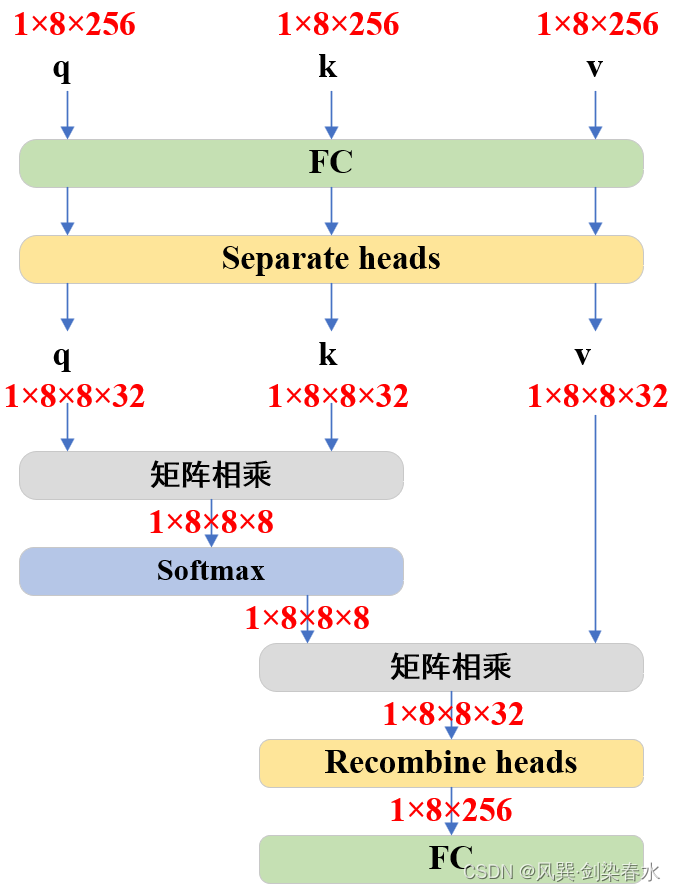
TwoWayAttentionBlock 结构如下:
以TwoWayTransformer的第一个TwoWayAttentionBlock模块为例,即:
TwoWayAttentionBlock(embedding_dim=embedding_dim, # 256num_heads=num_heads, # 8mlp_dim=mlp_dim, # 2048activation=activation, # nn.ReLUattention_downsample_rate=attention_downsample_rate, # 降采样率=2skip_first_layer_pe=(i == 0), # 第1个TwoWayAttentionBlock为True)
TwoWayAttentionBlock模块:
class TwoWayAttentionBlock(nn.Module):def __init__(self,embedding_dim: int,num_heads: int,mlp_dim: int = 2048,activation: Type[nn.Module] = nn.ReLU,attention_downsample_rate: int = 2,skip_first_layer_pe: bool = False,) -> None:super().__init__()self.self_attn = Attention(embedding_dim, num_heads) # embedding_dim=256, num_heads=8self.norm1 = nn.LayerNorm(embedding_dim) # 256self.cross_attn_token_to_image = Attention(embedding_dim, num_heads, downsample_rate=attention_downsample_rate) # embedding_dim=256, num_heads=8, attention_downsample_rate=2self.norm2 = nn.LayerNorm(embedding_dim) # 256# embedding_dim=256, mlp_dim=2048, activation=nn.ReLUself.mlp = MLPBlock(embedding_dim, mlp_dim, activation)self.norm3 = nn.LayerNorm(embedding_dim) # 256self.norm4 = nn.LayerNorm(embedding_dim) # 256self.cross_attn_image_to_token = Attention(embedding_dim, num_heads, downsample_rate=attention_downsample_rate) # embedding_dim=256, num_heads=8, attention_downsample_rate=2self.skip_first_layer_pe = skip_first_layer_pe # Truedef forward(self, queries: Tensor, keys: Tensor, query_pe: Tensor, key_pe: Tensor) -> Tuple[Tensor, Tensor]:# 输入queries:[1,8,256], keys:[1,4096,256], query_pe:[1,8,256], key_pe:[1,4096,256]# Self attention blockif self.skip_first_layer_pe:queries = self.self_attn(q=queries, k=queries, v=queries) # [1,8,256]else:q = queries + query_peattn_out = self.self_attn(q=q, k=q, v=queries)queries = queries + attn_outqueries = self.norm1(queries) # [1,8,256]# Cross attention block, tokens attending to image embeddingq = queries + query_pe # [1,8,256]k = keys + key_pe # [1,4096,256]attn_out = self.cross_attn_token_to_image(q=q, k=k, v=keys) # [1,8,256]queries = queries + attn_out # [1,8,256]queries = self.norm2(queries) # [1,8,256]# MLP blockmlp_out = self.mlp(queries) # [1,8,256]queries = queries + mlp_out # [1,8,256]queries = self.norm3(queries) # [1,8,256]# Cross attention block, image embedding attending to tokensq = queries + query_pe # [1,8,256]k = keys + key_pe # [1,4096,256]attn_out = self.cross_attn_image_to_token(q=k, k=q, v=queries) # [1,4096,256]keys = keys + attn_out # [1,4096,256]keys = self.norm4(keys) # [1,4096,256]return queries, keys
可以看到TwoWayTransformer的结构以及token维度变化并不复杂,但其交错的 Q {Q} Q, K {K} K, V {V} V 确实令人眼花缭乱:
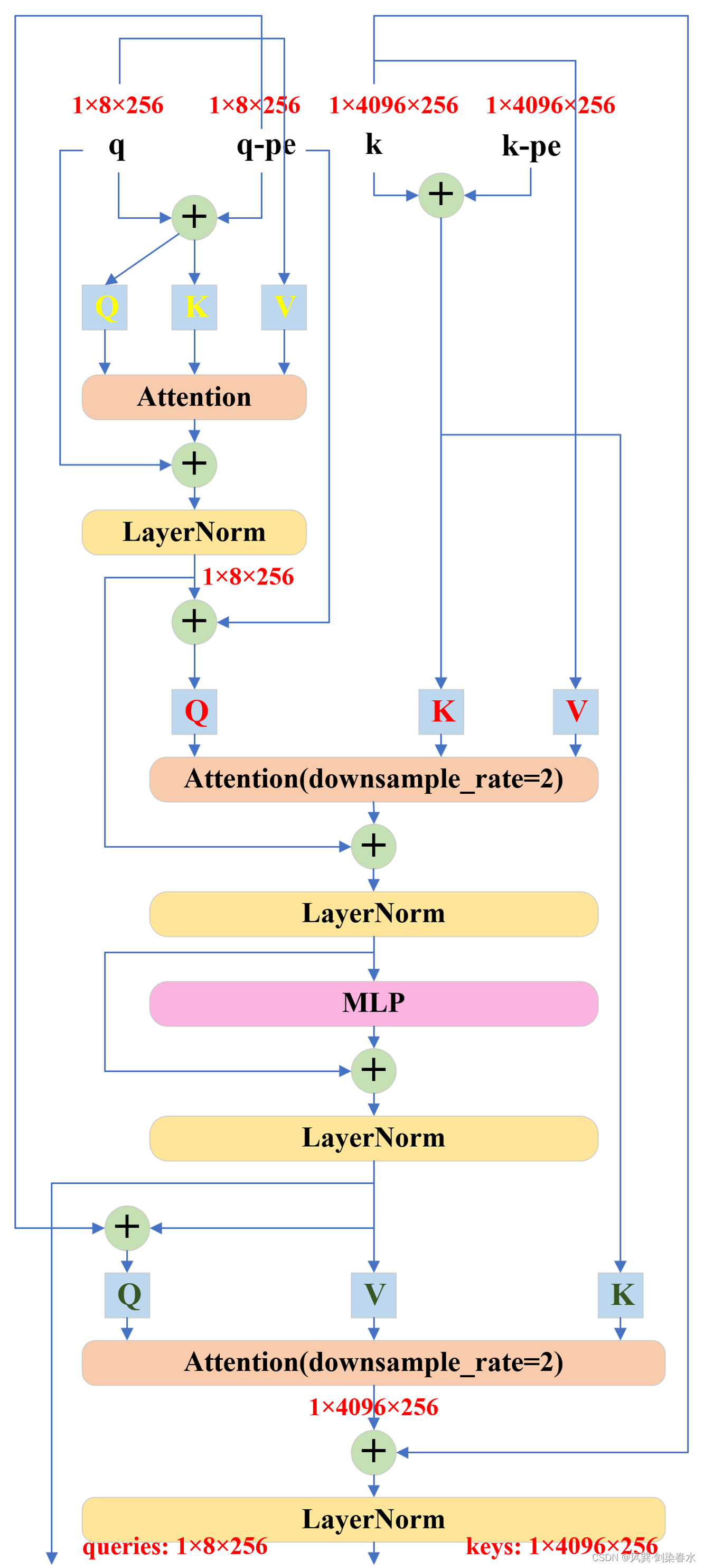
TwoWayTransformer中的MLP:
class MLPBlock(nn.Module):def __init__(self,embedding_dim: int,mlp_dim: int,act: Type[nn.Module] = nn.GELU,) -> None:super().__init__()# embedding_dim=256, mlp_dim=2048self.lin1 = nn.Linear(embedding_dim, mlp_dim) self.lin2 = nn.Linear(mlp_dim, embedding_dim)self.act = act()def forward(self, x: torch.Tensor) -> torch.Tensor:return self.lin2(self.act(self.lin1(x)))
MLP为简单的线性、激活、线性结构:
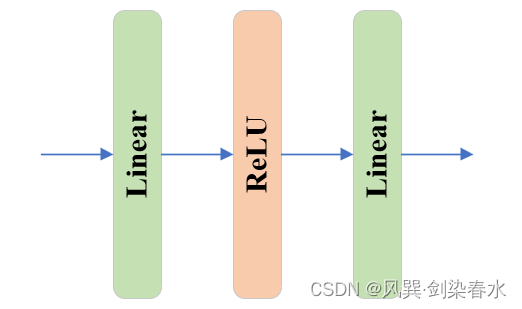
② output_upscaling:
Sequential((0): ConvTranspose2d(256, 64, kernel_size=(2, 2), stride=(2, 2))(1): LayerNorm2d()(2): GELU(approximate='none')(3): ConvTranspose2d(64, 32, kernel_size=(2, 2), stride=(2, 2))(4): GELU(approximate='none')
)
output_upscaling模块由两个反卷积、两个GELU激活和一个LayerNorm组成,实现了特征图的四倍上采样,在 predict_masks函数 中将 [ 1 , 256 , 64 , 64 ] {[1,256,64,64]} [1,256,64,64] 上采样至 [ 1 , 32 , 256 , 256 ] {[1,32,256,256]} [1,32,256,256] 。
src = src.transpose(1, 2).view(b, c, h, w) # reshape: [1,4096,256]-> [1,256,64,64]
upscaled_embedding = self.output_upscaling(src) # [1,32,256,256]
③ output_hypernetworks_mlps:
ModuleList((0-3): 4 x MLP((layers): ModuleList((0-1): 2 x Linear(in_features=256, out_features=256, bias=True)(2): Linear(in_features=256, out_features=32, bias=True)))
)
output_hypernetworks_mlps由4个MLP组成,在 predict_masks函数 中将 [ 1 , 256 ] {[1,256]} [1,256] 下采样至 [ 1 , 32 ] {[1,32]} [1,32] 。与TwoWayAttentionBlock中的MLP不同,其结构稍稍多一丢丢:
class MLP(nn.Module):def __init__(self,input_dim: int, # 256hidden_dim: int, # 256output_dim: int, # 32num_layers: int, # 3sigmoid_output: bool = False, # False) -> None:super().__init__()self.num_layers = num_layers # 3h = [hidden_dim] * (num_layers - 1) # [256,256]self.layers = nn.ModuleList(# [input_dim] + h: [256,256,256], h + [output_dim]:[256,256,32]nn.Linear(n, k) for n, k in zip([input_dim] + h, h + [output_dim]))self.sigmoid_output = sigmoid_outputdef forward(self, x):for i, layer in enumerate(self.layers):# i<2经线性层后relu激活x = F.relu(layer(x)) if i < self.num_layers - 1 else layer(x) if self.sigmoid_output:x = F.sigmoid(x)return x
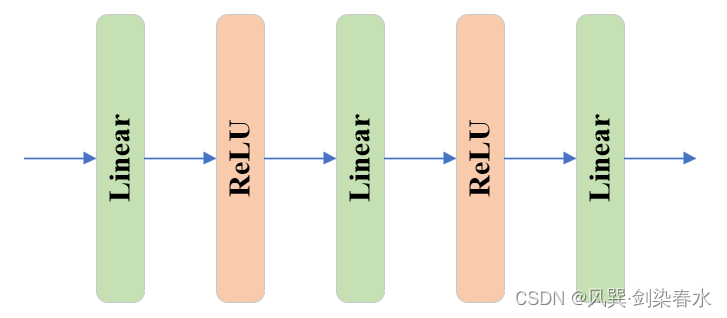
④ iou_prediction_head:
MLP((layers): ModuleList((0-1): 2 x Linear(in_features=256, out_features=256, bias=True)(2): Linear(in_features=256, out_features=4, bias=True))
)
iou_prediction_head用以实现iou预测,由1个MLP完成,其结构与output_hypernetworks_mlps中的MLP一样,只是最终将 [ 1 , 256 ] {[1,256]} [1,256] 映射至 [ 1 , 4 ] {[1,4]} [1,4] ,分别代表非multimask预测时的1个mask和multimask预测时的3个mask的iou。
(3)predict_masks函数
位置:【segment_anything/modeling/mask_decoder.py --> MaskDecoder类 --> predict_masks函数】
作用: 利用上述 t r a n s f o r m e r {transformer} transformer , o u t p u t _ u p s c a l i n g {output\_upscaling} output_upscaling , o u t p u t _ h y p e r n e t w o r k s _ m l p s {output\_hypernetworks\_mlps} output_hypernetworks_mlps 和 i o u _ p r e d i c t i o n _ h e a d {iou\_prediction\_head} iou_prediction_head 四个模块,实现mask和iou预测
此时此刻,首先来重温一下,传入predict_masks函数的参数分别是什么:
① image_embeddings:image encoder嵌入,大小为 [ 1 , 256 , 64 , 64 ] {[1, 256, 64, 64]} [1,256,64,64] ;
② image_pe:图像嵌入大小对应的位置编码,大小同为 [ 1 , 256 , 64 , 64 ] {[1, 256, 64, 64]} [1,256,64,64] ;
③ sparse_prompt_embeddings:prompt point和box嵌入,大小为 [ 1 , 3 , 256 ] {[1, 3, 256]} [1,3,256] ;
④ dense_prompt_embeddings:prompt mask嵌入,大小为 [ 1 , 256 , 64 , 64 ] {[1, 256, 64, 64]} [1,256,64,64] ;
def predict_masks(self,image_embeddings: torch.Tensor, # [1, 256, 64, 64]image_pe: torch.Tensor, # [1, 256, 64, 64]sparse_prompt_embeddings: torch.Tensor, # [1, 3, 256]dense_prompt_embeddings: torch.Tensor, # [1, 256, 64, 64]
) -> Tuple[torch.Tensor, torch.Tensor]:"""Predicts masks. See 'forward' for more details."""# Concatenate output tokens# 拼接iou的token和mask的token: [1,256]+[4,256]->[5,256]output_tokens = torch.cat([self.iou_token.weight, self.mask_tokens.weight], dim=0)output_tokens = output_tokens.unsqueeze(0).expand(sparse_prompt_embeddings.size(0), -1, -1) # [1,5,256]# iou的token和mask的token + prompt point和box嵌入tokens = torch.cat((output_tokens, sparse_prompt_embeddings), dim=1) # [1,8,256]# Expand per-image data in batch direction to be per-masksrc = torch.repeat_interleave(image_embeddings, tokens.shape[0], dim=0) # 按batch重复: [1,256,64,64]src = src + dense_prompt_embeddings # [1,256,64,64]pos_src = torch.repeat_interleave(image_pe, tokens.shape[0], dim=0) # 按batch重复: [1,256,64,64]b, c, h, w = src.shape # 1,256,64,64# Run the transformer# src是image encoder嵌入和prompt mask嵌入# pos_src是图像嵌入大小对应的位置编码# tokens是iou的token和mask的token + prompt point和box嵌入hs, src = self.transformer(src, pos_src, tokens) # hs:[1,8,256], src:[1,4096,256]iou_token_out = hs[:, 0, :] # 第1个为iou的token输出[1,256]mask_tokens_out = hs[:, 1: (1 + self.num_mask_tokens), :] # 随后4个为mask的token输出[4,256]# Upscale mask embeddings and predict masks using the mask tokenssrc = src.transpose(1, 2).view(b, c, h, w) # reshape: [1,4096,256]-> [1,256,64,64]upscaled_embedding = self.output_upscaling(src) # [1,32,256,256]hyper_in_list: List[torch.Tensor] = []for i in range(self.num_mask_tokens):hyper_in_list.append(self.output_hypernetworks_mlps[i](mask_tokens_out[:, i, :]))hyper_in = torch.stack(hyper_in_list, dim=1) # [1,4,32]b, c, h, w = upscaled_embedding.shape # 1,32,256,256masks = (hyper_in @ upscaled_embedding.view(b, c, h * w)).view(b, -1, h, w) # [1,4,256,256]# Generate mask quality predictionsiou_pred = self.iou_prediction_head(iou_token_out) # [1,4]return masks, iou_pred
由此可见,经TwoWayTransformer获得了iou_token_out和mask_tokens_out,iou_token_out由iou_prediction_head(1个MLP)实现iou预测,4个mask_tokens_out分别经过1个MLP所获得的映射拼接后,与经过output_upscaling上采样后的图像嵌入(包含image encoder嵌入和prompt mask嵌入)进行矩阵相乘,得到mask预测。
2. Mask Decoder结构绘制
(1)结构打印
MaskDecoder((transformer): TwoWayTransformer((layers): ModuleList((0-1): 2 x TwoWayAttentionBlock((self_attn): Attention((q_proj): Linear(in_features=256, out_features=256, bias=True)(k_proj): Linear(in_features=256, out_features=256, bias=True)(v_proj): Linear(in_features=256, out_features=256, bias=True)(out_proj): Linear(in_features=256, out_features=256, bias=True))(norm1): LayerNorm((256,), eps=1e-05, elementwise_affine=True)(cross_attn_token_to_image): Attention((q_proj): Linear(in_features=256, out_features=128, bias=True)(k_proj): Linear(in_features=256, out_features=128, bias=True)(v_proj): Linear(in_features=256, out_features=128, bias=True)(out_proj): Linear(in_features=128, out_features=256, bias=True))(norm2): LayerNorm((256,), eps=1e-05, elementwise_affine=True)(mlp): MLPBlock((lin1): Linear(in_features=256, out_features=2048, bias=True)(lin2): Linear(in_features=2048, out_features=256, bias=True)(act): ReLU())(norm3): LayerNorm((256,), eps=1e-05, elementwise_affine=True)(norm4): LayerNorm((256,), eps=1e-05, elementwise_affine=True)(cross_attn_image_to_token): Attention((q_proj): Linear(in_features=256, out_features=128, bias=True)(k_proj): Linear(in_features=256, out_features=128, bias=True)(v_proj): Linear(in_features=256, out_features=128, bias=True)(out_proj): Linear(in_features=128, out_features=256, bias=True))))(final_attn_token_to_image): Attention((q_proj): Linear(in_features=256, out_features=128, bias=True)(k_proj): Linear(in_features=256, out_features=128, bias=True)(v_proj): Linear(in_features=256, out_features=128, bias=True)(out_proj): Linear(in_features=128, out_features=256, bias=True))(norm_final_attn): LayerNorm((256,), eps=1e-05, elementwise_affine=True))(iou_token): Embedding(1, 256)(mask_tokens): Embedding(4, 256)(output_upscaling): Sequential((0): ConvTranspose2d(256, 64, kernel_size=(2, 2), stride=(2, 2))(1): LayerNorm2d()(2): GELU(approximate='none')(3): ConvTranspose2d(64, 32, kernel_size=(2, 2), stride=(2, 2))(4): GELU(approximate='none'))(output_hypernetworks_mlps): ModuleList((0-3): 4 x MLP((layers): ModuleList((0-1): 2 x Linear(in_features=256, out_features=256, bias=True)(2): Linear(in_features=256, out_features=32, bias=True))))(iou_prediction_head): MLP((layers): ModuleList((0-1): 2 x Linear(in_features=256, out_features=256, bias=True)(2): Linear(in_features=256, out_features=4, bias=True)))
)
(2)结构绘制
整体结构就是这样的啦,完结,撒花~
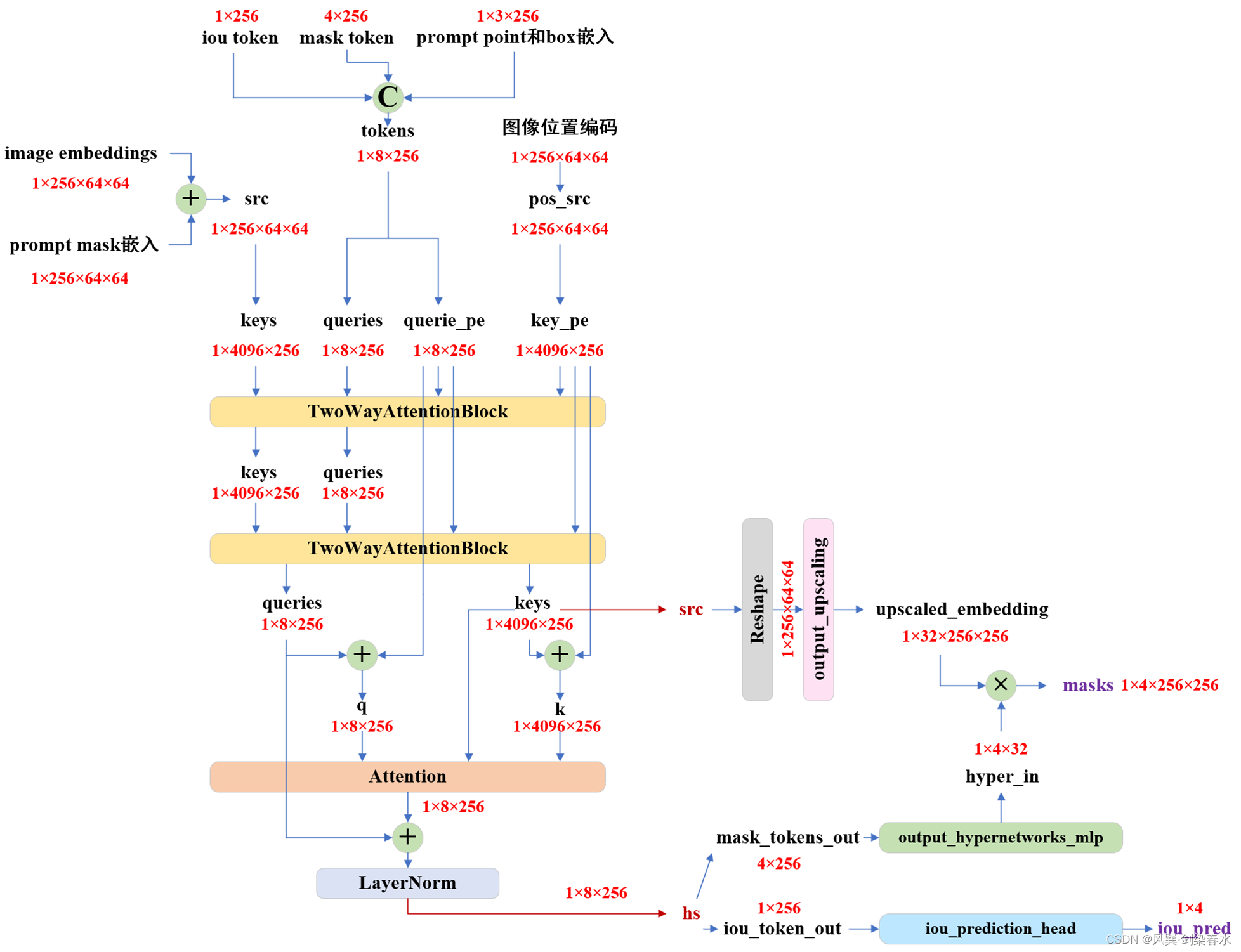
相关文章:

【技术追踪】SAM(Segment Anything Model)代码解析与结构绘制之Mask Decoder
论文:Segment Anything 代码:https://github.com/facebookresearch/segment-anything 系列篇: (1)【技术追踪】SAM(Segment Anything Model)代码解析与结构绘制之Image Encoder &am…...

认识Tomcat
文章目录 什么是tomcat?tomcat的使用tomcat的下载tomcat的目录结构tomcat的启动在tomcat上部署页面通过浏览器访问部署的页面 学习servlet的原因 什么是tomcat? 盖棺定论:Tomcat是一个HTTP服务器。 我们接下来要长期学习的东西都是关于前后…...

c语言通信之串口通信
在C语言中,可以使用串口通信、网络通信等多种方式实现计算机之间的通信。其中,串口通信通常用于近距离、低速率的通信,而网络通信则适用于远距离、高速率的通信。 下面以串口通信为例,介绍在C语言中如何实现串口通信。 1.打开串…...
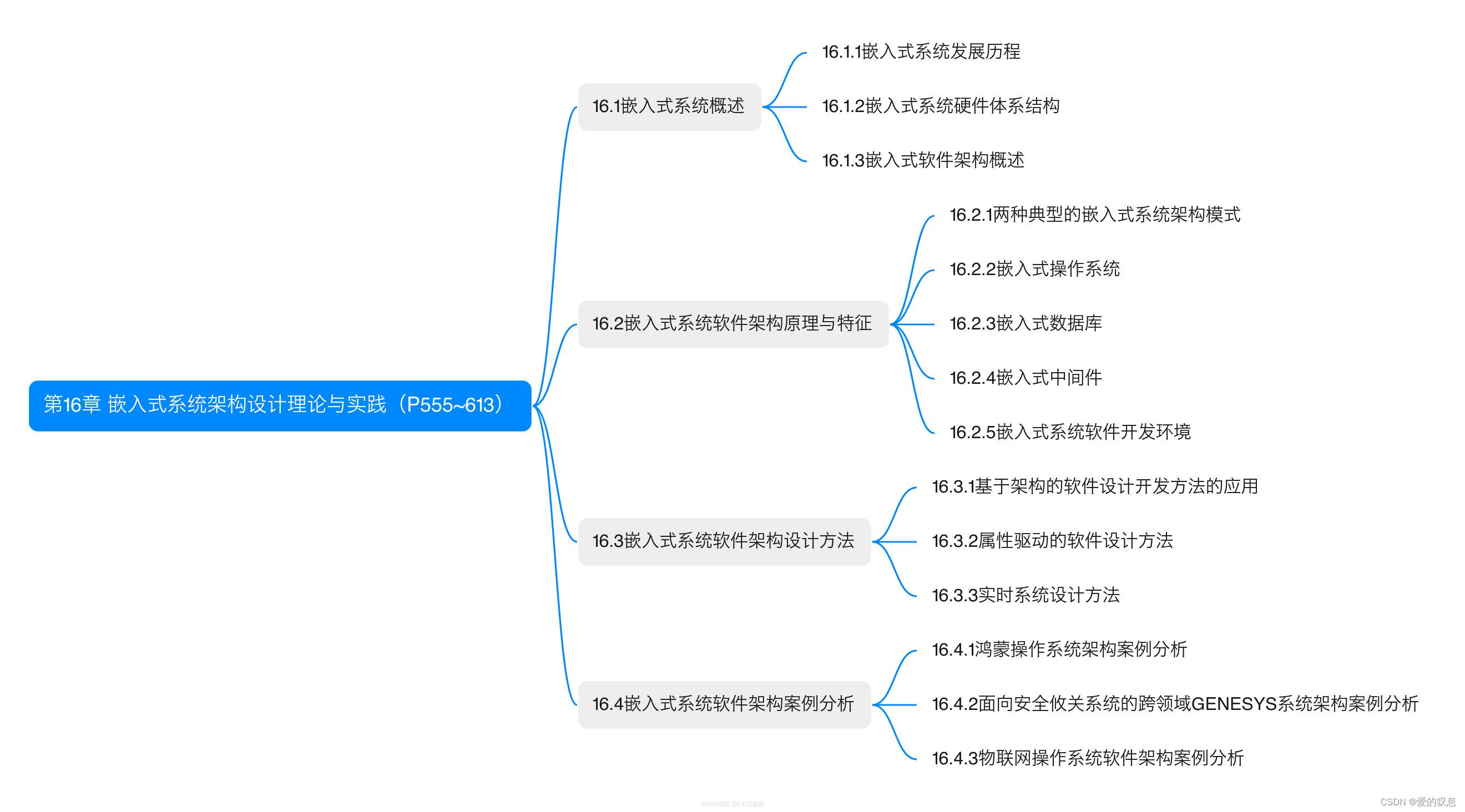
软考-高级-系统架构设计师教程(清华第2版)【第16章 嵌入式系统架构设计理论与实践(P555~613)-思维导图】
软考-高级-系统架构设计师教程(清华第2版)【第16章 嵌入式系统架构设计理论与实践(P555~613)-思维导图】 课本里章节里所有蓝色字体的思维导图...

2024年山东省职业院校技能大赛中职组 “网络安全”赛项竞赛试题-B卷
2024年山东省职业院校技能大赛中职组 “网络安全”赛项竞赛试题-B卷 2024年山东省职业院校技能大赛中职组 “网络安全”赛项竞赛试题-B卷A模块基础设施设置/安全加固(200分)A-1:登录安全加固(Windows, Linux)A-2&#…...

【Python数据结构与算法】——(线性结构)精选好题分享,不挂科必看系列
🌈个人主页: Aileen_0v0🔥系列专栏:<<Python数据结构与算法专栏>>💫个人格言:"没有罗马,那就自己创造罗马~" 时间复杂度大小比较 1.time complexity of algorithm A is O(n^3) while algorithm B is O(2^n). Which o…...
)
大数据-之LibrA数据库系统告警处理(ALM-12054 证书文件失效)
告警解释 系统在每天二十三点检查当前系统中的证书文件是否失效(即当前集群中的证书文件是否过期,或者尚未生效)。如果证书文件失效,产生该告警。 当重新导入一个正常证书,并且状态不为失效状态,该告警恢…...

Linux 之 journalctl 查看系统与 kernel 日志
目录 1. Linux 之 journalctl 查看系统与 kernel 日志 1. Linux 之 journalctl 查看系统与 kernel 日志 1 概述 日志管理工具 journalctl 是 centos7 上专有的日志管理工具, 该工具是从 message 这个文件里读取信息。Systemd 统一管理所有 Unit 的启动日志。带来的好处就是, …...

【PTA题目】7-3 冰雹猜想。 分数 10
7-3 冰雹猜想。 分数 10 全屏浏览题目 切换布局 作者 赵静静 单位 浙江工贸职业技术学院 冰雹猜想的内容是:任何一个大于1的整数n,按照n为偶数则除等2,n为奇数则乘3后再加1的规则不断变化,最终都可以变化为1。 例如ÿ…...

springBoot 配置druid多数据源 MySQL+SQLSERVER
1:pom 文件引入数据 <dependency> <groupId>com.alibaba</groupId> <artifactId>druid-spring-boot-starter</artifactId> <version>1.1.0</version> </dependency>…...
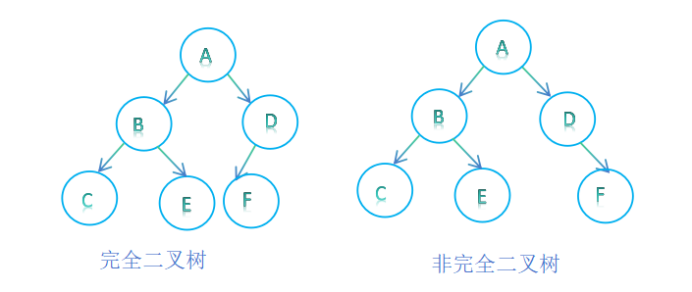
二叉树的创建与遍历
目录 前言: 二叉树的概念与结构 二叉树的链式存储 二叉树的创建 二叉树的销毁 二叉树结点个数计算 二叉树叶子结点个数计算 二叉树第k层节点个数的计算 二叉树高度的计算 二叉树查找值为x的结点 二叉树的遍历 二叉树的前序遍历 二叉树的中序遍历 二叉树…...

Mysql相关操作命令合集
参考文档:2021-06-25MySQL8.0创建用户和权限控制 - 简书 mysql登陆命令: mysql -u用户名 -p密码; 若遇到复杂密码,包含特殊字符,则需要做转义(以下密码为:rootry?elyl!): mysql…...
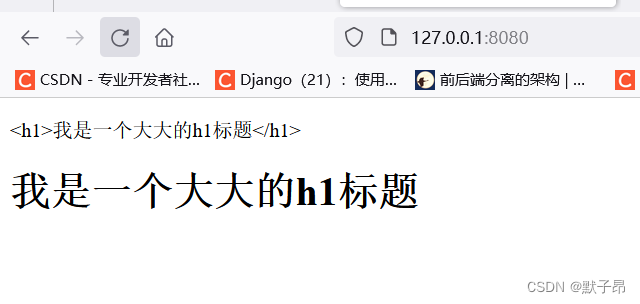
前端开发学习 (一) 搭建Vue基础环境
一、环境搭建 1、安装nodejs #下载地址 https://nodejs.org/dist/v20.9.0/node-v20.9.0-x64.msi 2、配置环境变量 上面下载完安装包后自行安装,安装完成后安装下图操作添加环境变量 #查看版本 node --version v20.9.0# npm --version 10.1.03、配置npm加速源 np…...

二维码智慧门牌管理系统升级解决方案:查询功能大提升,让地址查找变得轻松便捷!
文章目录 前言一、支持地址名称、小区等信息进行模糊查询二、支持地图上绘制多边形、圆形、矩形进行范围查询三、高效的数据处理能力,保证查询速度四、灵活的应用场景,满足多种需求 前言 随着科技的快速发展和城市化的加速推进,传统的门牌管…...
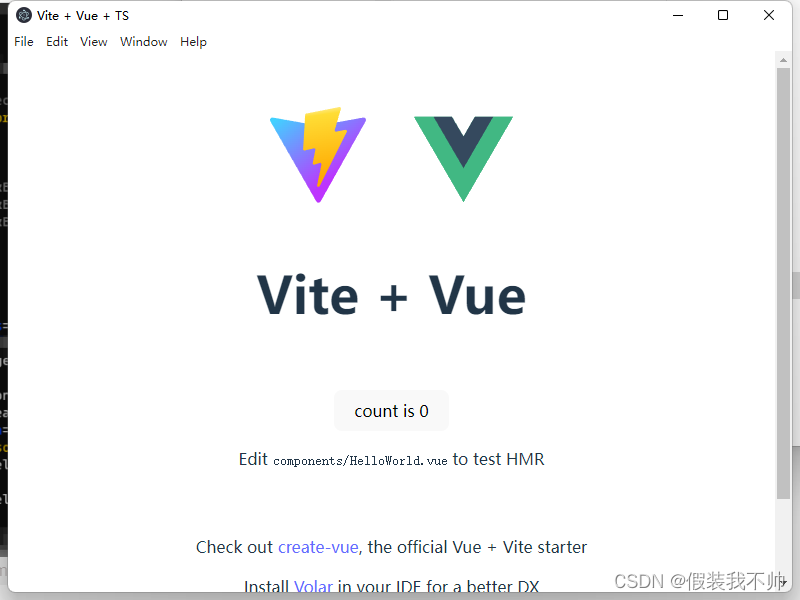
vite+vue3+electron开发环境搭建
环境 node 18.14.2 yarn 1.22 项目创建 yarn create vite test01安装vue环境 cd test01 yarn yarn dev说明vue环境搭建成功 安装electron # 因为有的版本会报错所以指定了版本 yarn add electron26.1.0 -D安装vite-plugin-electron yarn add -D vite-plugin-electron根目…...
:多态介绍与代码演示)
C#入门(9):多态介绍与代码演示
多态性是面向对象编程的一个核心概念,它允许你使用一个父类引用来指向一个子类对象。这可以使程序具有可扩展性,并且可以用来实现一些高级编程技术,如接口、事件、抽象类等。 多态相关的概念 以下是一些在C#中使用多态性的关键概念…...

可拖动、可靠边的 popupWindow 实现
0 背景 开发要实现一个可以拖动的圆角小窗,要求松手时,哪边近些靠哪边。并且还规定了拖动范围。样式如下: 1 实现 首先把 PopupWindow 的布局文件 pop.xml 实现 <?xml version"1.0" encoding"utf-8"?> <R…...

C# 依赖注入如何实现
在 C# 中,依赖注入(Dependency Injection,简称 DI)是一种编程技术,用于减少代码之间的耦合。依赖注入可以通过构造函数注入、属性注入或方法注入实现。在 .NET Core 和 .NET 5 中,还提供了一个内置的依赖注…...
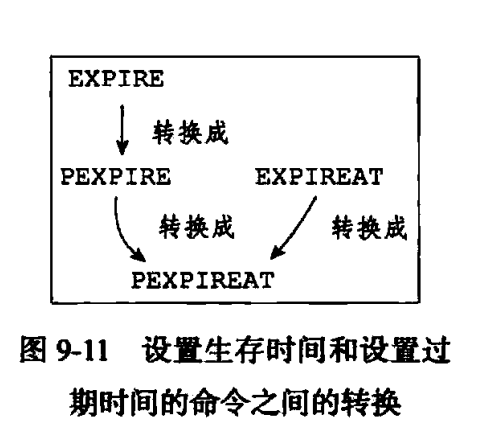
Redis 9 数据库
4 设置键的生存时间或过期时间 通过EXPIRE命令或者PEXPIRE命令,客户端可以以秒或者毫秒精度为数据库中的某个键设置生存时间(TimeToLive,TTL),在经过指定的秒数或者毫秒数之后,服务器就会自动删除生存时间…...

43-设计问题-最小栈
原题链接: 198. 打家劫舍 题目描述: 你是一个专业的小偷,计划偷窃沿街的房屋。每间房内都藏有一定的现金,影响你偷窃的唯一制约因素就是相邻的房屋装有相互连通的防盗系统,如果两间相邻的房屋在同一晚上被小偷闯入&a…...
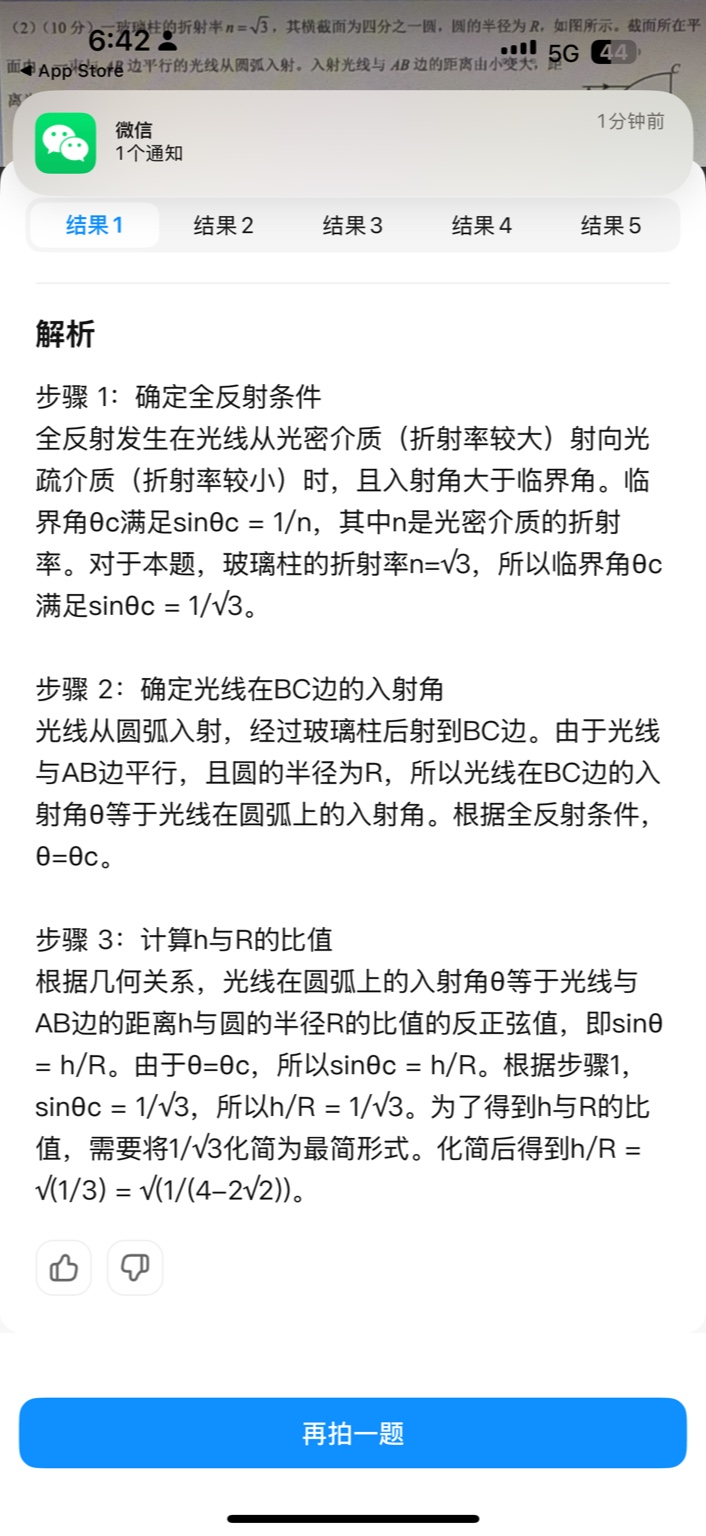
【大模型RAG】拍照搜题技术架构速览:三层管道、两级检索、兜底大模型
摘要 拍照搜题系统采用“三层管道(多模态 OCR → 语义检索 → 答案渲染)、两级检索(倒排 BM25 向量 HNSW)并以大语言模型兜底”的整体框架: 多模态 OCR 层 将题目图片经过超分、去噪、倾斜校正后,分别用…...

在四层代理中还原真实客户端ngx_stream_realip_module
一、模块原理与价值 PROXY Protocol 回溯 第三方负载均衡(如 HAProxy、AWS NLB、阿里 SLB)发起上游连接时,将真实客户端 IP/Port 写入 PROXY Protocol v1/v2 头。Stream 层接收到头部后,ngx_stream_realip_module 从中提取原始信息…...
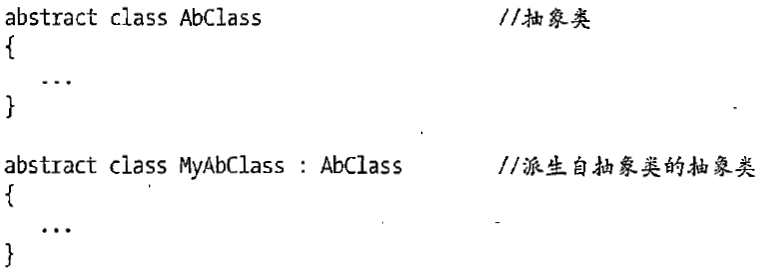
C# 类和继承(抽象类)
抽象类 抽象类是指设计为被继承的类。抽象类只能被用作其他类的基类。 不能创建抽象类的实例。抽象类使用abstract修饰符声明。 抽象类可以包含抽象成员或普通的非抽象成员。抽象类的成员可以是抽象成员和普通带 实现的成员的任意组合。抽象类自己可以派生自另一个抽象类。例…...

Mac下Android Studio扫描根目录卡死问题记录
环境信息 操作系统: macOS 15.5 (Apple M2芯片)Android Studio版本: Meerkat Feature Drop | 2024.3.2 Patch 1 (Build #AI-243.26053.27.2432.13536105, 2025年5月22日构建) 问题现象 在项目开发过程中,提示一个依赖外部头文件的cpp源文件需要同步,点…...

vulnyx Blogger writeup
信息收集 arp-scan nmap 获取userFlag 上web看看 一个默认的页面,gobuster扫一下目录 可以看到扫出的目录中得到了一个有价值的目录/wordpress,说明目标所使用的cms是wordpress,访问http://192.168.43.213/wordpress/然后查看源码能看到 这…...
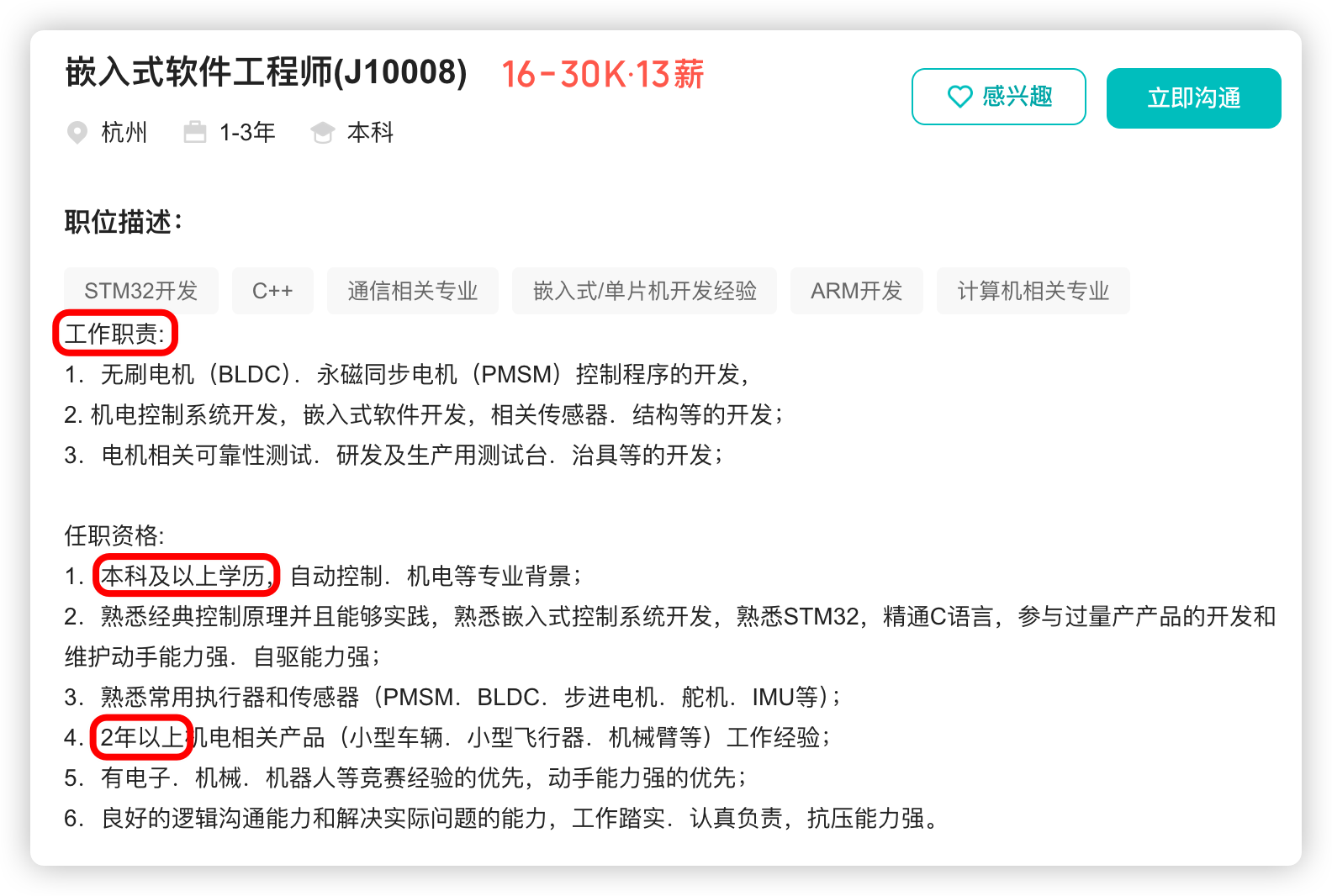
宇树科技,改名了!
提到国内具身智能和机器人领域的代表企业,那宇树科技(Unitree)必须名列其榜。 最近,宇树科技的一项新变动消息在业界引发了不少关注和讨论,即: 宇树向其合作伙伴发布了一封公司名称变更函称,因…...
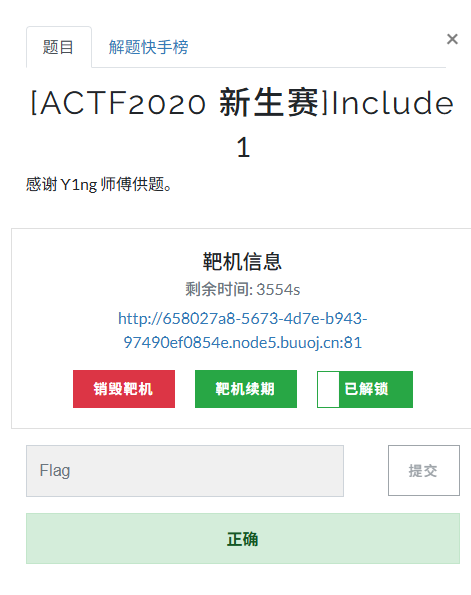
[ACTF2020 新生赛]Include 1(php://filter伪协议)
题目 做法 启动靶机,点进去 点进去 查看URL,有 ?fileflag.php说明存在文件包含,原理是php://filter 协议 当它与包含函数结合时,php://filter流会被当作php文件执行。 用php://filter加编码,能让PHP把文件内容…...
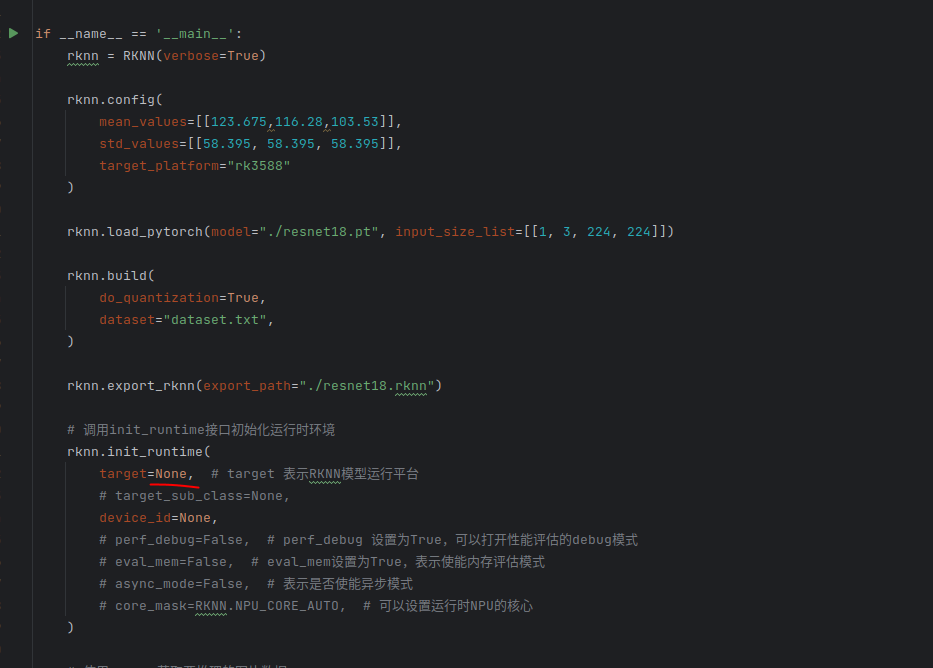
rknn toolkit2搭建和推理
安装Miniconda Miniconda - Anaconda Miniconda 选择一个 新的 版本 ,不用和RKNN的python版本保持一致 使用 ./xxx.sh进行安装 下面配置一下载源 # 清华大学源(最常用) conda config --add channels https://mirrors.tuna.tsinghua.edu.cn…...
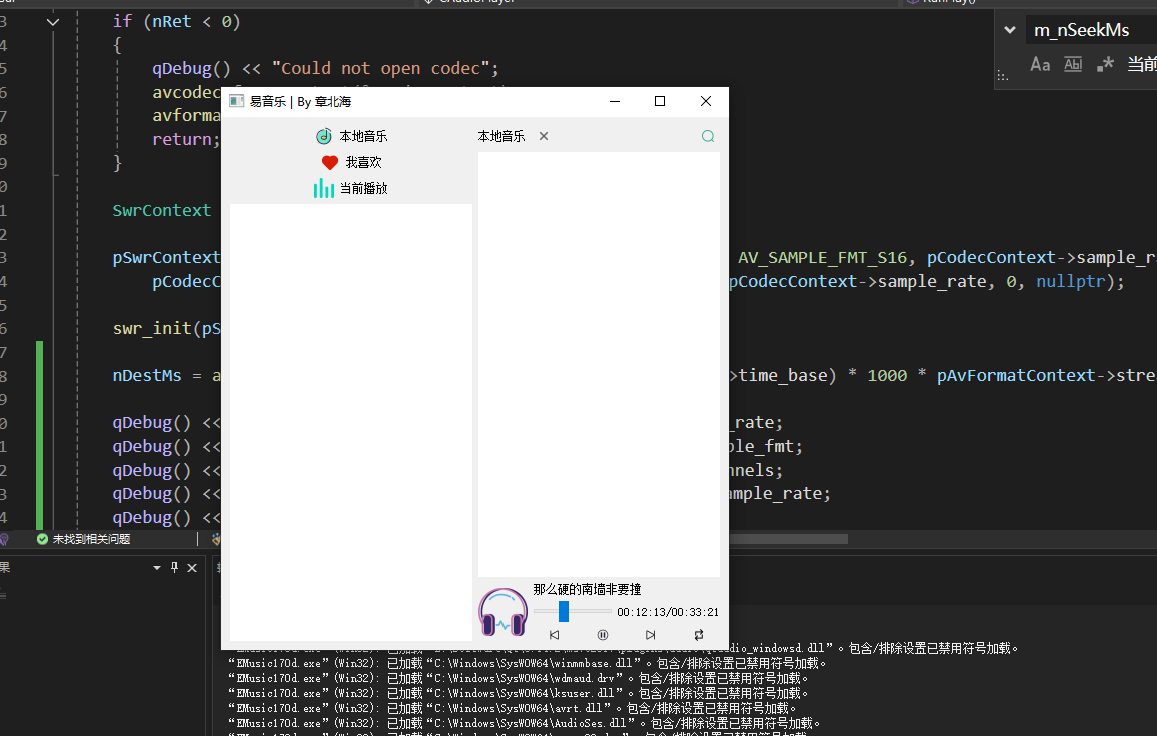
QT开发技术【ffmpeg + QAudioOutput】音乐播放器
一、 介绍 使用ffmpeg 4.2.2 在数字化浪潮席卷全球的当下,音视频内容犹如璀璨繁星,点亮了人们的生活与工作。从短视频平台上令人捧腹的搞笑视频,到在线课堂中知识渊博的专家授课,再到影视平台上扣人心弦的高清大片,音…...

C++--string的模拟实现
一,引言 string的模拟实现是只对string对象中给的主要功能经行模拟实现,其目的是加强对string的底层了解,以便于在以后的学习或者工作中更加熟练的使用string。本文中的代码仅供参考并不唯一。 二,默认成员函数 string主要有三个成员变量,…...
